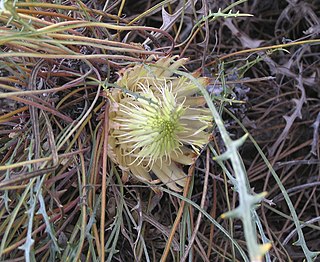Related Research Articles

The curlew sandpiper is a small wader that breeds on the tundra of Arctic Siberia. The genus name is from Ancient Greek kalidris or skalidris, a term used by Aristotle for some grey-coloured waterside birds. The specific ferruginea is from Latin ferrugo, ferruginis, "iron rust" referring to its colour in breeding plumage.

The ruddy shelduck, known in India as the Brahminy duck, is a member of the family Anatidae. It is a distinctive waterfowl, 58 to 70 cm in length with a wingspan of 110 to 135 cm. It has orange-brown body plumage with a paler head, while the tail and the flight feathers in the wings are black, contrasting with the white wing-coverts. It is a migratory bird, wintering in the Indian subcontinent and breeding in southeastern Europe and central Asia, though there are small resident populations in North Africa. It has a loud honking call.

Banksia rufa is a species of prostrate shrub that is endemic to the south-west of Western Australia. It has broadly linear, pinnatifid or pinnatipartite leaves with between five and twenty lobes on each side, yellow, orange or brownish flowers in heads of forty or more, and glabrous, egg-shaped follicles.
Banksia rufa subsp. magna is a subspecies of Banksia rufa. It was known as Dryandra ferruginea subsp. magna until 2007, when Austin Mast and Kevin Thiele sunk all Dryandra into Banksia. Since the name Banksia ferruginea had already been used, Mast and Thiele had to choose a new specific epithet for D. ferruginea and hence for this subspecies of it. As with other members of Banksia ser. Dryandra, it is endemic to the South West Botanical Province of Western Australia.
Banksia rufa subsp. chelomacarpa is a subspecies of Banksia rufa. It was known as Dryandra ferruginea subsp. chelomacarpa until 2007, when Austin Mast and Kevin Thiele sunk all Dryandra into Banksia. Since the name Banksia ferruginea had already been used, Mast and Thiele had to choose a new specific epithet for D. ferruginea and hence for this subspecies of it. As with other members of Banksia ser. Dryandra, it is endemic to the South West Botanical Province of Western Australia.
Banksia rufa subsp. flavescens is a subspecies of Banksia rufa. It was known as Dryandra ferruginea subsp. flavescens until 2007, when Austin Mast and Kevin Thiele sunk all Dryandra into Banksia. Since the name Banksia ferruginea had already been used, Mast and Thiele had to choose a new specific epithet for D. ferruginea and hence for this subspecies of it. As with other members of Banksia ser. Dryandra, it is endemic to the South West Botanical Province of Western Australia.
Banksia rufa subsp. obliquiloba is a subspecies of Banksia rufa. It was known as Dryandra ferruginea subsp. obliquiloba until 2007, when Austin Mast and Kevin Thiele sunk all Dryandra into Banksia. Since the name Banksia ferruginea had already been used, Mast and Thiele had to choose a new specific epithet for D. ferruginea and hence for this subspecies of it. As with other members of Banksia ser. Dryandra, it is endemic to the South West Botanical Province of Western Australia.
Banksia rufa subsp. pumila is a subspecies of Banksia rufa. It was known as Dryandra ferruginea subsp. pumila until 2007, when Austin Mast and Kevin Thiele sunk all Dryandra into Banksia. Since the name Banksia ferruginea had already been used, Mast and Thiele had to choose a new specific epithet for D. ferruginea and hence for this subspecies of it. As with other members of Banksia ser. Dryandra, it is endemic to the South West Botanical Province of Western Australia.
Banksia rufa subsp. tutanningensis is a subspecies of Banksia rufa. It was known as Dryandra ferruginea subsp. tutanningensis until 2007, when Austin Mast and Kevin Thiele sunk all Dryandra into Banksia. Since the name Banksia ferruginea had already been used, Mast and Thiele had to choose a new specific epithet for D. ferruginea and hence for this subspecies of it. As with other members of Banksia ser. Dryandra, it is endemic to the South West Botanical Province of Western Australia.
Banksia rufa subsp. rufa is a subspecies of Banksia rufa. It was known as Dryandra ferruginea subsp. ferruginea until 2007, when Austin Mast and Kevin Thiele sunk all Dryandra into Banksia. Since the name Banksia ferruginea had already been used, Mast and Thiele had to choose a new specific epithet for D. ferruginea and hence for this subspecies of it. As with other members of Banksia ser. Dryandra, it is endemic to the South West Botanical Province of Western Australia. As an autonym, it is defined as encompassing the type material of the species.

Lomatia ferruginea, commonly known as fuinque, is a small evergreen tree in the family Proteaceae.

Darlingia ferruginea, commonly known as the brown silky oak, is a rainforest tree of the family Proteaceae from Northern Queensland.
Helicia ferruginea, commonly named hairy honeysuckle or rusty oak, is a species of rainforest trees, of eastern Australia, from the flowering plant family Proteaceae.
Theocridini is a tribe of longhorn beetles of the subfamily Lamiinae. It was described by Thomson in 1858.
Planodema is a genus of longhorn beetles of the subfamily Lamiinae, containing the following species:

Hakea ferruginea, commonly known as rusty hakea, is shrub in the family Proteacea. It has flat leaves and white to cream-coloured flowers from late winter to mid-summer and is endemic to Western Australia.
Planodema flavovittata is a species of beetle in the family Cerambycidae. It was described by Stephan von Breuning in 1947.
Planodema congoensis is a species of beetle in the family Cerambycidae. It was described by Stephan von Breuning in 1942.
Planodema leonensis is a species of beetle in the family Cerambycidae. It was described by Stephan von Breuning in 1936.
Planodema granulata is a species of beetle in the family Cerambycidae. It was described by Per Olof Christopher Aurivillius in 1928. It is known from South Africa, Somalia, and Zimbabwe.
References
- ↑ BioLib.cz - Planodema ferruginea. Retrieved on 8 September 2014.